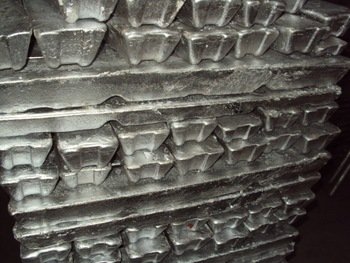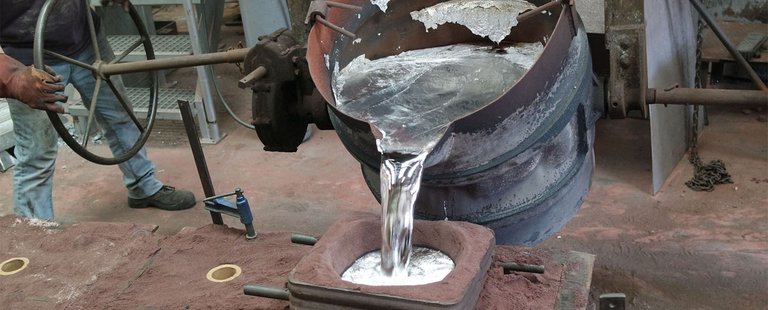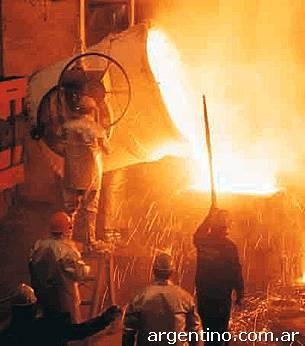Aluminum:
Aluminum is a chemical element, with symbol Al and atomic number 13. It is a non-ferromagnetic metal. It is the third most common element found in the earth's crust. Aluminum compounds make up 8% of the earth's crust and are present in most rocks, vegetation and animals.
Source
This metal has a combination of properties that make it very useful in engineering materials, such as its low density (2,700 kg / m3) and its high resistance to corrosion. By means of suitable alloys, its mechanical strength can be significantly increased (up to 690 MPa). It is a good conductor of electricity and heat, it is easily machined and it is very cheap. For all this it is from the middle of the 20th century the metal that is most used after steel.

Source
Characteristics
Aluminum is a very abundant element in nature, only surpassed by silicon and oxygen. It is a light metal, with a density of 2700 kg / m3, and with a low melting point (660 ° C). Its color is white and reflects well the electromagnetic radiation of the visible and thermal spectrum. It is a good electrical conductor (between 35 and 38 m / (Ω mm2)) and thermal (80 to 230 W / (m • K)).
Mechanical characteristics
Mechanically it is a soft material (Mohs scale: 2-3-4) and malleable. In pure state it has a tensile strength limit of 160-200N / mm2 (160-200 MPa).
All this makes it suitable for the manufacture of electrical cables and thin sheets, but not as a structural element. To improve these properties, it is alloyed with other metals, which allows casting and forging operations to be carried out on it, as well as the extrusion of the material. Also in this way it is used as welding.
Chemical characteristics
The valence layer of aluminum is populated by three electrons, so its normal oxidation state is III. This causes it to react with the Oxygen from the atmosphere rapidly forming a thin gray layer of alumina Al2O3, which covers the material, isolating it from further corrosion.
This layer can be dissolved with citric acid. However, it is so stable that it is often used to extract other metals from its oxides. Otherwise, aluminum dissolves in acids and bases.
Reacts easily with hydrochloric acid and sodium hydroxide.
Aluminum production
All aluminum production is based on the Hall-Herout process. The alumina is refined from the bauxite and dissolved in a bath with hydrofluoric salts. An electric current is then established in the bath to electrolyze the alumina dissolved with oxygen. The aluminum is then collected at the cathode and periodically extracted from the bath.

Source
The main impurities that are mixed with aluminum are iron and silicon, although zinc, titanium, vanadium and gallium can also be found.
The world production of aluminum is about 17,300,000 metric tons.
Aluminum series according to their alloys
Aluminum alloys are classified according to the alloying element used. The most commonly used alloying elements are:
• copper
• manganese
• silicon
• magnesium
• zinc
Contributions of alloying elements
The main aluminum alloying elements are the following and the advantages they provide are listed.
• Chromium (Cr) Increases mechanical strength when combined with other elements Cu, Mn, Mg.
• Copper (Cu) Increases mechanical properties but reduces resistance to corrosion.
• Iron (Faith). Increase the mechanical resistance.
• Magnesium (Mg) It has a great resistance after the cold forming.
• Manganese (Mn) Increases the mechanical properties and reduces the quality of drawing.
• Silicon (Si) Combined with magnesium (Mg), has greater mechanical strength.
• Titanium (Ti) Increases mechanical strength.
• Zinc (Zn) Increases the resistance to corrosion.
• Scandium (Sc) Improves welding. </ Div>
BIBLIOGRAPHY:
• VERLAG DUSSELDORF (2004), MANUAL OF ALUMINUM VOLUME II, EDITORIAL REVERETÉ, S.A., BARCELONA SPAIN, PAGE 114-167
• DITRICH G. ALTENPOHL, (1999), ALIMINUM; TECHNOLOGY, APPLICATIONS AND ANVIRONMENT.
• L.F.MONDOLFO, ALUMINUM ALLOYS, STRUCTURE AND PROPERTIES
• http://www.lenntech.es/periodica/elementos/al.html
With all the benefits in the material world, aluminium does have a demerit when it comes to cooking in Al utensils.
CheersNice one @borcast